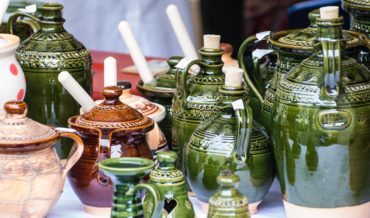An indulgence combined with a folk party, which took place every year in Krzemionki, near the church of St. Benedict next to the Krakus Mound. The name of the mound is associated with the legendary Krak – the fabulous ruler of Krakow. Linguists explain the origin of the name Rękawka from the Czech “rakew” – a coffin or the Serbian “raka” – a grave. However, the legend says that to commemorate Krak, the people built a mound, wearing soil in their sleeves, hence the name of the festival. It takes place on the first day after Easter. You are then full of stalls, sweets and toys. In addition, there are carousels, shooting ranges and more. The Tree of Life, which was so popular in the past, is no longer there – you can see it in the Ethnographic Museum. It is a carved tree with wooden birds lying on its twigs. Its name comes from the belief that people, after death, take the form of birds, sit on twigs and rest. We will no longer find there clay bells and axes at the fair. The Rękawka was strongly associated with folk rituals, since ancient times all souls’ were fired, evil spirits were scared away and funeral banquets were organized. During the ceremony, the remnants of holy food from Easter egg, sausage and cakes were thrown to honor souls. After some time it ends, and in 1820 Konstanty Majeranowski recreated it. Rękawka is located in Podgórze, and during the times of the Republic of Krakow, the Vistula was the border of the Free City of Krakow, and the Austrian authorities did not look favourably on these rites, and as a result, they were banned.
Suggested
Suggested contents and articles.
Suggested Contents
A district of Krakow lying on the right bank of the Vistula. As a result of the First Partition of Poland in 1772, the Austrians took the entirety of Lesser Poland to the Vistula River, and Krakow became a border city. The area of today’s Podgórze also includes former villages
- Knowledge Base, Places to visit
- February 9, 2021
Every year in August, Krakow Main Market Square is crammed with stalls selling folk arts and crafts. Folk Art Fair lasts for over two weeks and occupies a large part of the Main Square in front of the Cloth Hall. In addition to selling all sorts of folk goods and
- Events
- April 10, 2017
Contents1 Kosciuszko Mound2 Krakus Mound3 Wanda Mound4 Pilsudski Mound The four Mounds of Krakow are forever inscribed in the landscape of the city and its surroundings. Two of them were built to commemorate Polish national heroes – Tadeusz Kosciuszko and Jozef Pilsudski. The real purpose of the other two’s creation
- Places to visit
- March 24, 2017
Comments
All comments.
Comments

